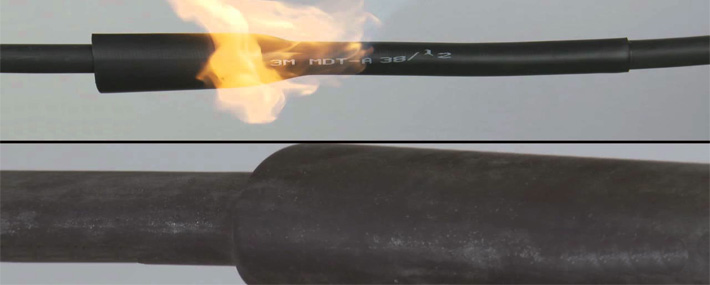Cold Shrink and Heat Shrink tubing may appear similar from the outside, but their key characteristics are very different. Both types of tubing have different installation techniques, applications and physical properties.
HeatShrink and ColdShrink tubing can be used for a variety of cabling applications including: terminating, splicing and providing environmental seals on LV and MV cables. More than price, ease of use and environmental conditions should be taken into consideration when choosing the most suitable product.
The differences
The most obvious differences between the two products are how each of them is applied. Cold Shrink comes stretched over a removable plastic core, allowing the tube to be slid over the application, the core removed and the tubing will contract to create a watertight-seal around the cable or connection due to the ‘active memory’ contained within the EPDM rubber or silicone material. Heat Shrink, also comes pre-stretched but as a sleeve rather than over a removable core. The sleeve requires a heat source for installation, usually from a gas torch, to heat the polyolefin tubing so that it shrinks to its original size, creating a seal over the cable or joint.
Silicone-rubber Cold Shrink tubing has the greater UV-resistance of all the types of cold or heat-applied tubing and is therefore used in outdoor, exposed environments, for example: trackside terminations to rail power lines. EPDM rubber is also used in Cold Shrink tubings and is much more abrasion resistant than other cold or heat-applied products, being ideally suited for direct burial applications such as cable-to-cable jointing.
Cold Shrink tubing has an “active memory” seal characteristic, meaning the tubing is always trying to return to its original size and able to maintain its sealing capability around cables as they expand and contract under large load-swings or temperature fluctuations.
Another advantage of Cold Shrink tubing is that, because there is no direct flame required to install components, there is a reduced risk to the installer, especially in the presence of combustible gasses. Hot-work permits are not required and quality and reliability of the installation is guaranteed due to fewer critical installation techniques, with resultant time and cost savings.
The polyolefin-based material used in Heat Shrink is resistant to most chemicals and also becomes very rigid once it has been heated, therefore making it a good choice for mechanical protection. However, the downside to this rigidity is the products inability to expand and contract with the cable, meaning an environmental seal cannot be maintained without the aid of hot-melt adhesives or mastic tapes. Heat Shrink materials are not suited for installation areas experiencing high heat or humidity, but are ideal for use in most industrial/commercial installations where operating temperatures are below 90oC and where chemical resistance is required.
Video: ColdShrink Joint vs HeatShrink Joint
Knowing which one to choose
Every cabling installation has a number of different requirements when it comes to chemical, abrasion and moisture resistance. When adding space limitations and temperature considerations into the equation, choosing the correct product can become difficult and confusing. Ultimately, ETS can provide a vast selection of Heat Shrink and Cold Shrink products to suit a wide variety of cable accessory requirements from low-voltage straight joints, all the way up to 72kV distribution line terminations.
If you found this article helpful or interesting, please share it!














